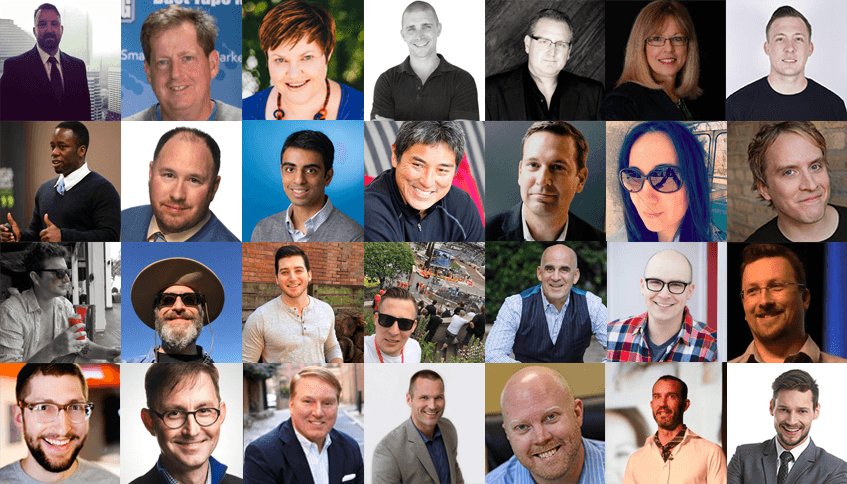25 Experts Share Top 3 Content Marketing Trends for 2023

Content marketers who keep track of the current trends will have an advantage when it comes to planning for the future.
Isn’t it great when you know which way content marketing is heading in the next few years and which areas to focus your efforts on?
So, to find out what to expect from content marketing in the future, we reached out to 25 experts and asked them this question:
What are your top 3 content marketing trends for 2023 and beyond?
Their responses offer a variety of predictions, and many believe that more focus will be placed on live video, visual content, interactive content, virtual reality, personalised and niche content, content promotion and distribution, and that more businesses will seek out content creators and marketers. Some see the focus shifting towards writing longer, better quality, more in-depth content, while others think that the trend of too much bad quality content will continue.
We’ve listed all the responses below:
Top 3 Content Marketing Trends for 2023 and Beyond
(According to 25 Experts)
A. Aaron Agius, Adrian Cordiner, Andrew Davis, Andy Crestodina
C. Chad Pollitt, Chris Garrett, Cindy Readnower
D. Donna Moritz
F. Frank Strong
H. Hana Abaza
J. Joel Klettke, John Jantsch, Jordan Scheltgen
M. Marcus Sheridan, Mark Schaefer, Matthew Grant, Michael Brenner
S. Scott Severson, Steven Sefton
T. Ted Rubin

Aaron Agius
1) Personalisation. Content that is created and focussed as much as possible on specific people and personas. This allows the content to be of as much value as possible to the readers.
2) Interactive Content. Professionally designed and developed content that enables readers to choose different paths in the content, click on sections that are of interest and are applicable, and that is more entertaining than the standard text heavy content we see today.
3) Data Lead Content. Content that is driven by data that supports and proves interest in the topic, and that shows that there is a hungry audience behind the content being created.
Aaron Agius is a marketer, web strategist, and entrepreneur. Find more about him at louder.online.

Adrian Cordiner
- More rich media content – video, interactive tools, gamification – as audience tastes and expectations evolve, so will the types of content being created.
- More niche content – with the escalating arms race, and the massive volumes of content being created on a daily basis (2+ million blog posts per day), it’s getting more and more expensive and time-consuming to create content. It won’t be possible for smaller companies to compete on broader topics (which are getting saturated anyhow), and so people will direct their focus towards narrower niches, personalised content, more targeted channels, where they’ll get lower volume but higher quality engagement.
- Higher rates for content creators – outsourcing and freelancing has commoditised much of content creation (such as design and copywriting). However, as the stakes and levels of entry get higher, and as people start to realise that the content they’re creating represents their brand, companies will start to see the value in investing in premium quality content creation.
Adrian Cordiner is the director of Digital Rhinos and Prozely.

Andrew Davis
- A split within Social media and content: Social Media will be split into 2 areas, the visual web and the community focused web. Visual content will increase at a rapid pace but so will messaging platforms.
- Algorithms will play a bigger role in how your content will be seen. We are already seeing it with the big social platforms.
- A lot of brands will give up on content marketing as they are not seeing short term results. This can be a great thing for anyone who is playing the long game.
Andrew Davis is a social media consultant and trainer and has worked with some of the biggest brands and celebrities over the last 17 years. Based in the UK and having worked in digital content for some of the largest organisations (BBC & MySpace), he now has carved a niche for himself in the training sector and also has a cool site called Thinking Outside The Blog.

Andy Crestodina
- Google will buy Twitter for tens of billions of dollars. They won’t change Twitter much, but there will be more ads. The ROI for buying advertising in Twitter will go up.
- Machine learning will become part of optimization tools. Tools like Unbounce will make recommendations based on huge data sets and then let you make changes with a single click. Websites will continually optimize themselves for better conversions and usability.
- Live events will set huge attendance records and companies will all try to get more live events into their mix of content types.
Andy Crestodina is the co-founder and strategic director at Orbit Media. Find more about him on Twitter.

Chad Pollitt
- Content marketers will be demanding AND receiving much larger budgets for content promotion and distribution.
- Native advertising networks, third-parties and managed service providers will offer cost per engagement (CPE) post-click buying options. This is a must-have for content marketers.
- Agencies and publishers’ content studios will compete head to head for enterprise content marketing business.
Chad Pollitt is VP of Audience and co-founder of Relevance. Find more about him at www.chadpollitt.com.

Chris Garrett
I see prospects are retreating from blanket marketing and are consuming and acting on more personalized, niche content and discussions more than ever. So for my new site http://makerhacks.com I have been promoting to specific audiences for each piece of content, rather than try to find people who are interested in everything I write about. You will see more movement from marketers towards adaptive content and granular marketing automation sequences.
It’s also clear that customers are sick of the brute force tactics, misleading, bait and switch messaging, and clickbait. People are increasingly cynical and protective of their inbox, they won’t respond just because something is free and has a “you will never guess what happens next” headline!
Last, virtual reality and augmented reality is right now a bleeding edge field, but in the coming years expect it to go mainstream, and that could change a lot for all kinds of business.
Chris Garrett is an online business consultant, teacher, coach, new media industry commentator, writer, and speaker. Find more about him at http://www.chrisg.com/.

Cindy Readnower
- People are inundated with information. They will continue to click away from anything that is not easy and convenient to read. Blogs that are too long, have too many pop-ups that obscure the main text, or do not have enough pictures and images to intrigue the reader, will not get read.
- Those that are active on social media need lots of good content to post and this will continue. If you want to be re-tweeted or shared, you need to have something different to say. Keep your message designed to entertain or educate. Get to the point quickly and give your reader something to take away from their time spent reading your content. They don’t want to hear about your angst, they want to know what’s in it for them.
- People will start to click away from sensationalist headings. Those words that you see everywhere such as, “You won’t believe this,” or “Shocking truth revealed,” have been overused with content that does not live up to the hype. People will wise up and avoid the time spent only to be disappointed.
Cindy Readnower is an author, columnist, and owner of Skinny Leopard Media. Find more about her at cynthiareadnower.com and on Twitter.

Donna Moritz
- Live Video will be integral to a true connection with your audience.
- Paid Social will be accepted as a necessary part of any social media strategy.
- More than ever we will need to be “human” in our marketing as fans want to know the people behind the brand.
Donna Moritz is a social media strategist and visual marketing specialist. Find more about her at sociallysorted.com.au.

Frank Strong
- A re-evaluation of content output. Research shows upwards of 60-70% of B2B content goes unused. In content marketing, more and better seem to be two divergent trends. Instead of creating more, brands will focus on creating better.
- A renewed focus on content distribution. This goes hand-in-hand with the first trend in that brands will seek to get more out of existing content. This calls for a renewed focus on distribution including channel development, maturity and content re-purposing.
- Buy vs. build an audience. The shift in social media towards a paid model demonstrates the value of building an owned media platform and developing a community online for brands. However, for those just getting started, they may not have the time or patience it takes to foster a community. In that case, there is another option: buy it. For example, while many see Microsoft’s acquisition of LinkedIn as a technology or data position, some see it as play for the audience. Indeed, over the next several years we’ll see more and more brands looking at opportunities to buy into a content marketing plan by acquiring media outlets.
Frank Strong is the founder & president of Sword and the Script Media.

Glen Gilmore
Content marketing success will demand that marketers get much more tech and data savvy. Prepare to create more video, do more live-streaming and dive into the rabbit hole of augmented (AR) and virtual reality (VR).
AR, VR, and the Internet of Things (IoT) are coming of age and create incredible opportunities for marketers.
The best content marketers will be those who tap into the incredible data being generated by so many connected devices and the new platforms being spawned by IoT, AR and VR.
Leveraging User-Generated Content will make the journey easier. And think personalization.
Glen Gilmore is a digital marketing strategist, author of Social Media Law for Business, and has ranked as a Forbes Top 20 “Social Media Power Influencer”. Find more about him at www.glengilmore.com and on Twitter.

Guy Kawasaki
Live video, live video, and live video.
Guy Kawasaki is the chief evangelist of Canva, an online graphic design tool. He is on the board of trustees of the Wikimedia Foundation, a brand ambassador for Mercedes Benz USA, and an executive fellow of the Haas School of Business (UC Berkeley). He was also the chief evangelist of Apple. He is also the author of The Art of the Start 2.0, The Art of Social Media, Enchantment, and nine other books. Kawasaki has a BA from Stanford University and an MBA from UCLA as well as an honorary doctorate from Babson College.

Hana Abaza
According to a study by CMI and Marketing Profs over 70% of B2B and B2C marketers plan to produce more content in 2016 than the previous year. But only 20% of marketers can measure the success of their content. While I believe the increase in content creation will continue in 2017, there will be a greater focus on measuring the value and success of your content efforts across key performance metrics that impact the business.
We’ve all heard that people are betting big on video (especially Facebook) – while a shift in content formats will skew to more visual forms (like video) there will still be a need and demand for long-form content. Writing isn’t dead.
Marketers are starting to understand that great content isn’t enough to meet their goals. They need to create a well-optimized and targeted content experience. Moving into 2017, marketers will place a bigger emphasis on creating compelling experiences that are integrated into their overall strategy and technology stack.
Hana Abaza is a digital marketer and the VP of Marketing at Uberflip. Find more about Hana Abaza at hanaabaza.com and on Twitter.

Joel Klettke
A shortage of capable content creators (seller’s market).
- There’s still way more demand for capable content creators than supply to fill it – so those who are exceptional at their work will continue to be able to command strong rates and stay very, very busy.
Focus shifting away from long-form content.
- So much emphasis has been placed on long-form content for SEO, links and so on – but the smart companies are realizing that an enormous guide isn’t always what their leads need.
Growth in visual content.
- Writers have ruled the roost for a long time – but more companies are tapping into video, slideshares and the visual elements of written content to differentiate – so design folk will be busy for a long, long time.
Joel Klettke is a copywriter and digital marketer. Find more about him at businesscasualcopywriting.com and casestudybuddy.com.

John Jantsch
Less is more – Longer, more in-depth content is the bar for entry now – the 300–500 word warmed over blog post, no matter how often it’s posted, won’t cut it. 1500–2000 words with lots of value. The good news is you can write less often and still benefit.
Lead capture is personal – Driving traffic to your content is essential, but the ultimate payoff is capturing a lead for future content. The generic eBook won’t drive conversion any more. Your lead capture device must be highly in line with the topic that attracts the reader.
Content drives advertising – Advertising effectiveness will soar if you adhere to points one and two!
John Jantsch is a marketing consultant, speaker and author of Duct Tape Marketing, Duct Tape Selling, The Commitment Engine and The Referral Engine, and is the founder of the Duct Tape Marketing Consultant Network. Find more about him at ducttapemarketing.com.

Jordan Scheltgen
In 2017 and afterwards, we’re going to see a couple things happen with regards to content marketing.
(i) More and more businesses will seek out to hire content creators and marketers, not merely hand off the marketing responsibilities to someone juggling several other jobs within an organization.
(ii) There will be a big focus on quality over quantity; producing one great piece of content will produce more positive results for a company than 100 mediocre pieces.
(iii) Snapchat will no longer be a novelty, but something most businesses have, accompanied closely with the use of live video on Facebook/Periscope.
Jordan Scheltgen is a Managing Partner at Cave Social.

Kohlben Vodden
- Artificial Intelligence – A truly fascinating trend is the emergence of AI journalism companies such as Narrativa and Narrative Science that use data to create human quality text based content. We see a not too distant future where AI creates content along side writers and is managed by tech savvy editors.
- Immersive Content Formats – A little more obvious is the pervasive adoption of immersive content formats such as 360 video and Virtual reality by your audiences. These formats are fast moving beyond the realm of early adopters and with both Facebook and YouTube both now supporting these formats, you can expect to see widespread audience adoption in 2017/2018.
- Science-based content marketing – StoryScience is pioneering this new evolving field of content marketing. Science-based content marketing combine behavioural, data and cultural science with creative storytelling to plan and deliver advanced content marketing solutions that surpass best practice benchmarks.
After over a decade of future proofing and delivering competitive advantage for the world’s best-known brands, by commercialising emerging consumer and technology-driven trends, Kohlben Vodden predicted a seismic industry change towards science-based marketing solutions and left the global agency world to launch StoryScience and who are pioneering science-based content marketing.

Marcus Sheridan
- Many companies will fail at content marketing because they feel it’s too complicated and competitive – therefore not worth trying.
- More and more companies will start to embrace in-house video content, hiring their own videographers and eventually, offering more video-based content than text.
- More than ever, companies will seek after recent journalist graduates to fill their content and social media marketing needs.
Marcus Sheridan is the president of marcussheridan.com.

Mark Schaefer
The most important trend is the increase in information density. A few years ago content was a still a novelty, but now it is harder to compete and stand out.
So the second trend is that content is no longer the finish line. It is the starting line. Most businesses will need a promotion and distribution strategy.
Finally, virtual reality will be mainstream in a few years. This will change how we tell our stories and connect to customers in profound ways.
Mark Schaefer is a college educator, marketing consultant, and author of five marketing books including The Content Code.

Matthew Grant
Top Trend #1: People will continue to churn out crappy content
As someone who has been producing “content” – in one form or another – for the last 16 years, I’ve been alarmed at the sheer quantity of content that is being produced and saddened by its diminishing quality and utility. I do not see this trend abating. There is more stuff out there than anyone can “consume” (let alone digest) and, unfortunately, when people do take the time to dig in, they will find the dish none too satisfying. I do not see the flow ebbing.
Top Trend #2: Content will get useful or get ignored
As I said, there’s too much content and too much of what’s out there just isn’t any good. It’s either a rehash of what someone else said or it’s written at such a high level, that you can’t apply it to anything. For content to have an impact, it needs to be useful. This means, first and foremost, that you can’t create content for everyone. You have to create content for a specific community that is dealing with specific problems, and your content has to address and, ideally, solve those problems. Content created within communities will continue to be valuable. Everything else will not.
Top Trend #3: Marketers will realize that it is not about the content
When talking about content being useful, it’s important to remember that content has a number of uses. Yes, it can be used to learn something (like how to open a durian fruit or improve your email subject lines), but you can also use it to grow or interact with an audience. In fact, the audience, in the end, is more important than any one piece of content. For example, when a company licenses a Forrester report (or an Aberdeen report <wink>) for a demand generation campaign, there are only two things that matter: the title and the fact that it comes from Forrester.
Will the people who fill out the form to download it read it?
Who knows!
If they filled out the form, the content served its purpose. Content marketers need to keep their eye on the ball. Unless you are selling your content directly, which 99.9% are not, then the “use” of the content does not reside in the content, but in its use and usefulness for the business.
Matthew Grant is Director of Content Strategy at Aberdeen Essentials.

Michael Brenner
- Brands find a niche. As more and more content is being published, brands will find that they need to define a topic or niche that they can own – one that truly reflects their unique expertise and reason for being. We’ll see a shift away from generic content on broad topics to more specific areas of coverage in brand’s content marketing efforts.
- Visual content continues to dominate. As a society we are consuming more visual content. This will push brands to define strategies and to hire experts in the fields of design, photography, videography, data visualization, and visual storytelling.
- Personalization. It’s tough to break through the noise. Brands will start to target content down to individual preferences, desires, and interests.
Michael Brenner is CEO of Marketing Insider Group, co-author of the best-selling book The Content Formula, and one of the leading voices in Marketing today. Follow Michael on Twitter (@BrennerMichael) and connect with him on LinkedIn.

Nathan Ellering
Predictive data shows blogs, social media, and video will undeniably continue to flourish into 2017 and beyond. Additionally, my fun predictions are that smart marketers will begin to invest in bigger content projects like creating free and robust online tools, writing the go-to books in their industries, and creating environments where their customers can build a community to share knowledge.
Nathan Ellering is the content marketing lead a CoSchedule. Find more about him on Twitter.

Pawan Deshpande
Paid social and promoted content will become a major and standard way that content is promoted.
The line between content creation and content curation will blur.
B2B content marketers will be held accountable not just for how much content they create, but what it does for the business much like demand generation teams.
Pawan Deshpande is the CEO of Curata.

Scott Severson
- Focus on efficiency
As companies continue to invest in content marketing, there is a tremendous opportunity for content marketers to focus on content operations. Selecting the right content marketing platform can help marketers create more and better content in less time.
- The rise of the Content Librarian
According to a recent survey, 50% of marketers now have more content than they can efficiently manage. The Content Librarian, whose job is to organize, label, and manage content, can solve for the “content shock” marketers are experiencing.
- User-generated content
It’s nothing new, but user generated content is how time-strapped content marketers can gather, moderate and distribute content at scale.
With nearly two decades of experience in digital marketing, Scott Severson is a passionate advocate of digital content marketing and combining storytelling with technology to grow businesses. In his role as Brandpoint’s President, Scott works with a broad array of brands and agencies to craft strategic, effective and measurable content marketing programs.

Steven Sefton
With 200 million blog posts being published every day, the need for creating deep content is more apparent. Take this article your reading for instance. There are multiple experts feeding you their best tips from all around the world. Getting all these experts together is no easy task and making sure the article is promoted properly and a huge success is even harder.
The best thing about it is most people are inherently lazy. If you can be the one who creates articles that is the best on that subject, and follow up with an amazing promotion plan, you’ll forever change your business.
Instead of posting a 500 word article every week, spend more time and create an article around a subject that is going to be a powerful asset to your website.
Take this article named ‘Top 100 Scottish Wedding Venues in Scotland‘ from a Ceilidh Wedding Band called The Jiggers. It’s the best on the subject. It’s also generated nearly 57,000 new people to their site and ranks in the top page of Google for over 30 keywords and phrases.
This type of content creation and traffic can be a game-changer for small businesses.
Quality trumps quantity. Without a promotion plan, your content won’t go anywhere. When you create a new article, make sure it’s the best article online for that subject.
Find more about Steven Sefton at seftonmedia.com and on Twitter.

Ted Rubin
2017 needs to be the year of doing what I call… Looking People in the Eye Digitally. The last few decades of marketing tactics have made us lazy communicators and I’ve had just about enough. Most often we don’t even pay attention to who we are talking to other than via the data we collect (and even that’s a maybe). In order to fix this and really start to benefit from the content we produce (both as individuals and as companies), we need to start looking people in the eye digitally… which means “Listening, Connecting, Relationships.”
Ted Rubin is a social marketing strategist, brand evangelist, keynote speaker, and acting CMO of Brand Innovators. He has also ranked #13 on Forbes Top 50 Social Media Power Influences. Sign up for his newsletter, watch his talk, and find more about him at www.ror.online and tedrubin.com.
A huge thank you to all the experts who contributed to the post. What do you think content marketing trends will be for the years to come?
We’d love to hear your thoughts on these trends, and your content marketing predictions for 2017 and beyond. Please share in the comments below.

Comments (0)